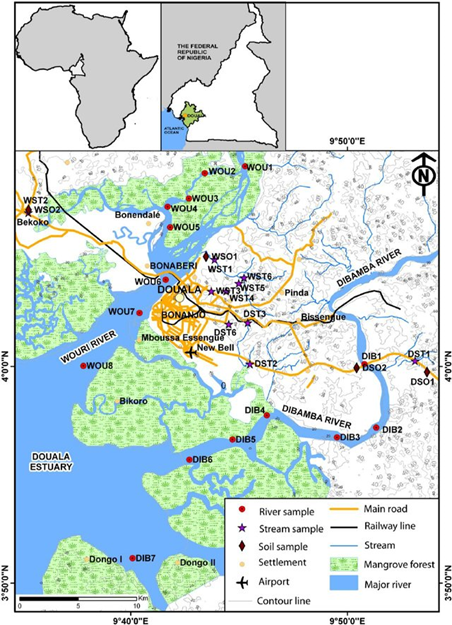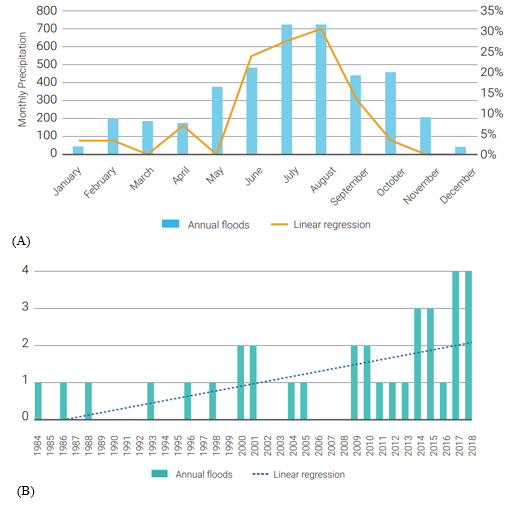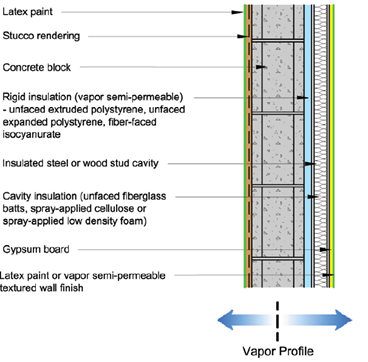International Journal of
eISSN: 2576-4454


Research Article Volume 7 Issue 1
Environmental Engineer and Researcher
Correspondence: Abanda Well Victorien Bienvenu, Environmental Engineer and Researcher, Cameroon
Received: December 30, 2022 | Published: January 10, 2023
Citation: Abanda Well VB. Prevention and treatment of home moisture: the case of Douala city. Int J Hydro. 2023;7(1):1-7. DOI: 10.15406/ijh.2023.07.00333
Many cities of the world are affected by home moisture. This is typically the case of Douala city. The negative impact of home moisture on the human life and buildings are very important. Thus, it is a health and environmental concern. Many factors such as flooding, poor material for building construction, non-mastery of construction technics, poor drainage network and low visibility of hazards cartography increase the vulnerability of houses to moisture. To mitigate this problem, the study recommends: the construction of more drainage networks, the vulgarization of flood cartography, the mastering of construction technics to mitigate moisture and people sensitization about the effect of home moisture on their health.
Keywords: home moisture, flood, drainage network, municipality, government
Moisture is the presence of water on air or any substance. Moisture is very important for human life as it helps to mitigate the impact of solar radiation on the body especially during dry seasons. However, it has detrimental effects for building constructions and human being living inside. These impacts are: ugliness of the houses, fast degradation of equipment, corrosion, caught, asthma and wheeze, etc.1 Thus, it is a health and environmental issue of concern. According to Lu et al.2 the major sources of house moisture are: precipitation, ground and surface water, sewerage systems, use of wet materials in construction, plumbing leakage, inhouse water used by humans. Home moisture is particularly present in Cameroon cities. Its progression is exacerbate by the non application of building construction standards and the aboundancy of rainy events. Douala is one of the cities of Cameroon that is mostly impacted by home moisture owing to its proximity with many rivers, soil structures, climate and urbanism.
Rationale
This article is interesting because it is the first that address solutions to mitigate home moisture in Cameroon. Furthermore, if home moisture is not well managed, it may lead not only to sanitary crisis in Cameroon but also abroad as Douala is a cosmopolite city.
Objectives
The objective of this work is to investigate the reasons of home moisture in Douala and to determine appropriate methods to mitigate them.
Physical environment
Douala (Figure 1) is the most populated area in Cameroon and the CEMAC zone. It has an average population of 4 Million inhabitants and an average density of 18 935 hab/km2. Four main seasons govern the weather of Douala: the great rainy season (June to October), the great dry season (November to mid of March), the small rainy season (mid of March to mid of April) and the small dry season (mid of April to May). Climate variability disturbs ordinary season trend. Soil texture varies with the location (Table 1). It can take the form of sandy loam, loamy sand, silt loam and clay. The main rivers surrounding the city are Dibamba and Wouri, that are tributary of the Atlantic Sea (Figure 1). This contribute to make water table very close to the ground. The city is frequently suggested to flood events3 especially during the month of August which is the rainiest month (Figure 2). In reaction of the usual flooding events, the municipality of Douala in partnership with AFD (Agence Française de Developpement) have invested on the construction of drainage networks all around the city through the project named “Projet de Drainage Pluvial (PDP)”. The project started on 2015 and is actually in its second phase. Despite the execution of the first stage of the project that enabled the construction of more than 30 km of drainage canals all around the city, the frequency of flooding events has not decreased (Figure 2) and even seems to intensify.4 This may be explained by the climate change5 and the improper disposal of garbage that saturates the drainage canals and water body.6
Site |
Number |
Sand (%) |
Silt (%) |
Clay (%) |
Textural class |
|
Wouri River |
Akwa North |
WS01 |
64.4 |
30.8 |
4.8 |
Sandy loam |
Bekoko Junction |
WS02 |
78.2 |
17.8 |
4 |
Loam Sandy |
|
Dibamba River |
Missole |
DS01 |
20.2 |
72 |
7.8 |
Silt loam |
Dibamba |
DS02 |
37.2 |
13.8 |
49 |
Clay |
Table 1 Soil texture of Douala
Source: Tening et al.20

Figure 1 Presentation of Douala; source: (Tening et al., 2013).20

Figure 2 Monthly (a) and yearly (b) distribution of flooding events; Source: UN HABITAT.9
Legal and institutional framework
The major actors involved in the regulation of the construction of buildings in cities are: the Ministry of Housing and Urban Development, Douala city council, Ministry of territorial administration. Their actions are framed by the Law N° 2004-003 of April 21. 2004 governing urbanism and DECREE N° 2008 / 0739 / PM OF APRIL 23, 2008 fixing the rules of land use and construction.
Economic and social aspect
At Douala, some constructions are located near wetlands and riverbeds.7 Lands suitable for constructions are expensive and not affordable to everyone.8 Many buildings are constructed with temporal materials9 and the buildings of some quarters such as Bepanda and Ndogpassi are much densified. The frequency of removal of waste is not proportional to the country growing economy and population.6 Thus, improper disposal of waste is highly frequent. Principles for building construction to prevent home hazards are not always respected.10
In order to determine measures to control home moisture in the study area, I will evaluate the consequences of each aspect of the physical, economic, social and institutional context. Then for each of the findings, I will determine appropriate solutions based on root cause analysis (RCA) methodology. Among the package of solutions proposed by USEPA11 I will sort those which fit very well with Douala.
|
Risky event |
Root Cause Analysis |
Impact |
Actions |
Responsible |
|
Construction located near wetland and occupation of riverbed |
‣ Land not expensive; ‣ Proximity with work |
Recurrence of flooding event |
‣ The municipality should not deliver construction permit to those who want to construct near wetland and riverbed; ‣ Cartography of all the unsafe areas of the city should be made available on the web site of the Municipality. |
‣Government and Municipality |
|
Land suitable for construction are expensive and not affordable to everyone |
‣ These lands are generally located near paved roads with a good drainage system this increase the price of acquisition |
People prefer to construct in unsafe areas |
‣ Multiplication of SIC houses: Houses with an affordable price that are constructed by the government to help poor people; ‣ Pavement of the roads and construction of drainage systems should continue. |
‣Government; ‣Municipality |
|
buildings are constructed with temporal material |
‣ Poverty; ‣ Illicit occupation of the public space: people often extend their construction to the public area. Thus, when the government want to construct a road or any infrastructure, destruction of some illicit buildings occurs. |
Easy access of water inside houses |
‣ Sensitization; ‣ relocation of people; ‣ Non-construction on the public area; ‣ Financial compensation. |
‣ NGOs; ‣ Municipality; ‣ Government |
|
Improper disposal of waste |
‣ Un-civilization of people; ‣ low presence of trash cans to collect waste; ‣ disposal of trash cans near drainage systems that favor their obstruction when the trash can is full; ‣ A single company is in charge of waste removal such that if it has some disturbance, waste will not be removed. |
Obstruction of the drainage system that is built to funnel the water in natural waterbody. |
‣ Intensification of the Sensitization and education of people about the importance of proper disposal of waste; ‣ Increase the number of collection points for waste; ‣ removal of collecting points near drainage networks; ‣ Multiplication of the actors in charge of collection of waste: the municipality can take incharge the management of waste as it is the case of the city of Dschang. |
‣ Municipality; ‣ Private sector; ‣ Government |
|
Densification of the construction |
‣ Absence of money to buy more space; ‣ Rural exodus; ‣ Non-respect of urbanism plan. |
‣ Reduction of water runoff; ‣ low ventilation of houses and exposure to sun; ‣ mould and related diseases. |
‣ Relocation of people; ‣ Treatment of mould; ‣ Development of all the locality of the country to limit rural exodus |
‣ Municipality; ‣ Government; ‣ Professors; ‣ NGOs |
|
Proximity of the city with waterbodies |
‣ Natural |
‣ Capillary movement of water that favor the presence of water in the house. |
‣ respect of construction standards |
‣ Engineers |
|
Soil texture (Sandy soils) |
‣ Natural |
‣ easy infiltration of water inside the soil and facilitation of capillary movement of water towards the foundation and the walls |
‣ respect of construction standards |
‣ Engineers |
|
Principles to prevent home moisture during home construction are not respected |
‣ Low budget for construction; ‣ knowledge default |
‣ Presence of home moisture in the house and the associate diseases. |
‣ Respect of construction principles to mitigate home moisture; ‣ Long and short term Training to make methods to treat and prevent home moisture; ‣ Publications |
‣ Engineering school; ‣ Government |
Below are illustrated some construction principles from USEPA11 that can be applicable to Douala for home moisture mitigation.
Site drainage
Foundation
Walls
Figure 7, 8, 9, 10, 11, 12, 13.

Figure 11 Concrete Block with Interior Rigid Insulation Frame Wall with Cavity Insulation and Stucco.

Figure 12 Frame Wall with Exterior Rigid Insulation with Cavity Insulation and Brick or Stone Veneer.
Roof and celling assembly
Plumbing and inspection

Figure 15 Three-Dimensional Drawing Detailing Rainwater Control Continuity at Intersection of Goose Neck Vent, Flashing and Roofing Membrane.

Figure 17 Moisture Control in an Inverted Membrane Roof with Heavy Steel Frame and Light Steel In-Fill.
It should be designed in a way to facilitate inspection and maintenance. Material to be used should be repeatedly wet and dried. Inspection should be done regularly to assess water leakage inside the wall or roof. If yes, maintenance should be by avoiding material that have low affinity with humidity.
Other methods
Cement industry develop more waterproof concrete that have the ability to limit moisture. There are also some specific resins that are used to treat moisture walls. All these products are available in the local market.
After analyzing the context, we found that solutions to mitigate home moisture in Douala are: the non-occupation of wetland and riverbeds, the cartography of moisture area, road pavement and continuation of the drainage network, construction of SIC houses, education and trainings, relocation of people to safe zones, mastering of technics to mitigate home moisture, etc. The achievement of these actions involves the collaboration of many stakeholders such as the Municipality, the government, the NGOs, the engineering school and the private sector.
These findings are perfectly aligned with WHO (2010), who thinks that people holding academic knowledges on mould removal have a positive impact on the fighting against home moisture. Action of municpality as well as sensitization also help to achieve that objective. Schmitt et al.12 and Hsiang-Kuan Chang et al.13 thinks that the optimization of sewage drainage systems is very important to fight against flooding that lead to home moisture. Thus, the government should plan the construction of the 250 km of drainage network in Douala as preconised by MINEPAT14. Improper disposal of waste that lead to blocage of waterbody and drainage network was also found as an issue of concern by Abanda15 thus sensitization should be done continuously to change behavior. Emile Temgoua16 also thinks that the municipality should play a major role on the removal of waste and the provison of sanitation system to empower the action of the government and to prevent hazards17,18,4 elaborates cartography of flooding sensitive area of Douala. Unfortunately, such documents are not exploited by the municipality which can publish them on their website. Nganya et al.19 provide further characteristics regarding buildings construction in terms of walls, roof and soil specific for Douala city. The aim is to build bioclimatic houses. Thus the solution proposed in this article can be contextualised with the one proposed by such author in order to maximize the comfort of the occupants. The Legal and regulatory framework of Cameroon already describes the procedure to establish a building permit. Meanwhile, the government should also sensitize people on the construction methods to avoid this issue of moisture by producing documentation such as the one proposed by USEPA11 which is very useful. Engineering schools should also insist on moisture control during the academic curriculum of students.21,22
Moisture is a major problem for most countries especially the city of Douala that has an environment favorable for its development when taking into account the soil, the hydrography and the climate. This study elaborates many recommendations involving many stakeholders such as the municipality, the government and the civil society. Vulgarization of construction technics to prevent moisture, the education and awareness of people, increase of flood mapping visibility, construction of the 250 km drainage networks appears as some solutions to treat this problem. The government should also fight against poverty as it leads people to live in unsafe areas. It is very important to implement these recommendations as the phenomenon is increasing despite many efforts. The Cameroon government set the cap of its emergency in 2035; the achievement of this objective cannot be done by ignoring house moisture as it directly affects human life and infrastructures. Difficulties related to this study were the scarcity of data on the topic. It is a general problem that may negatively affect researchers. In this study, we have not taken into account the financial aspect of the solution proposed as well as the integration of local material.
None.
The author declares there is no conflict of interest.

©2023 Abanda. This is an open access article distributed under the terms of the, which permits unrestricted use, distribution, and build upon your work non-commercially.